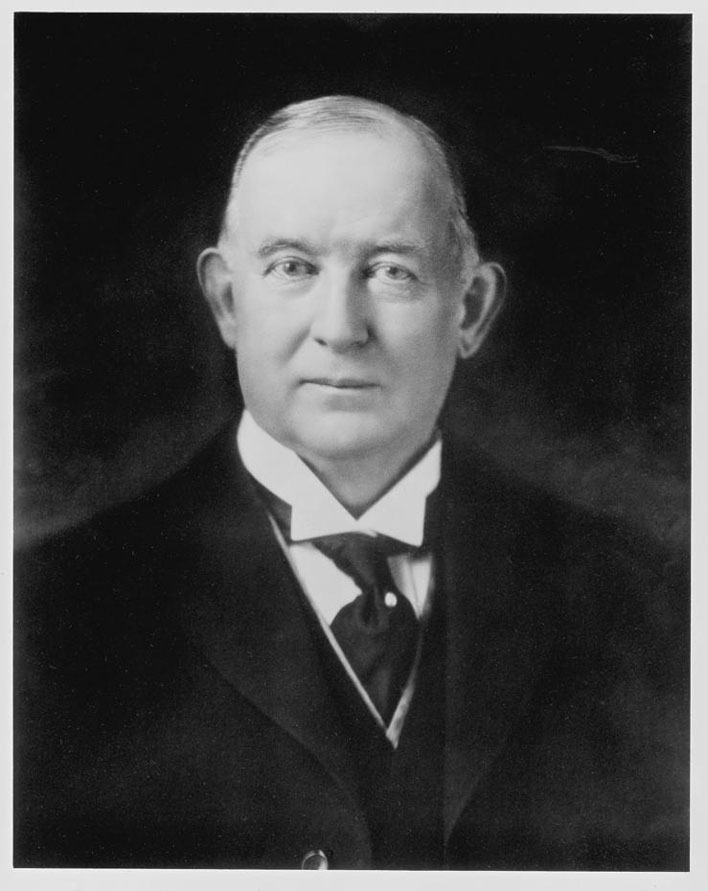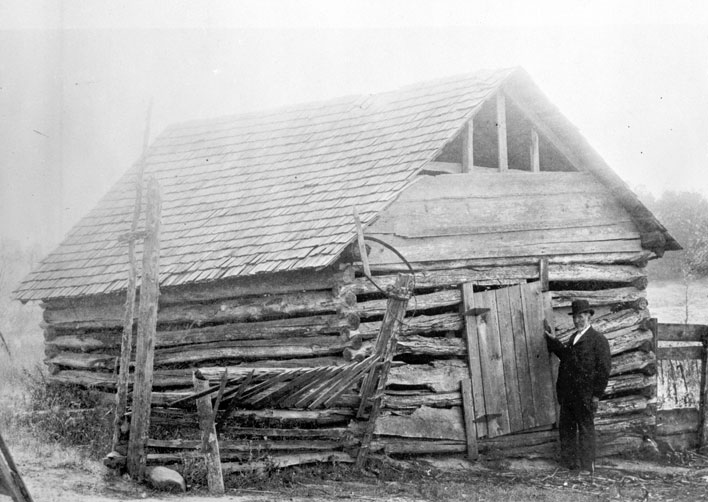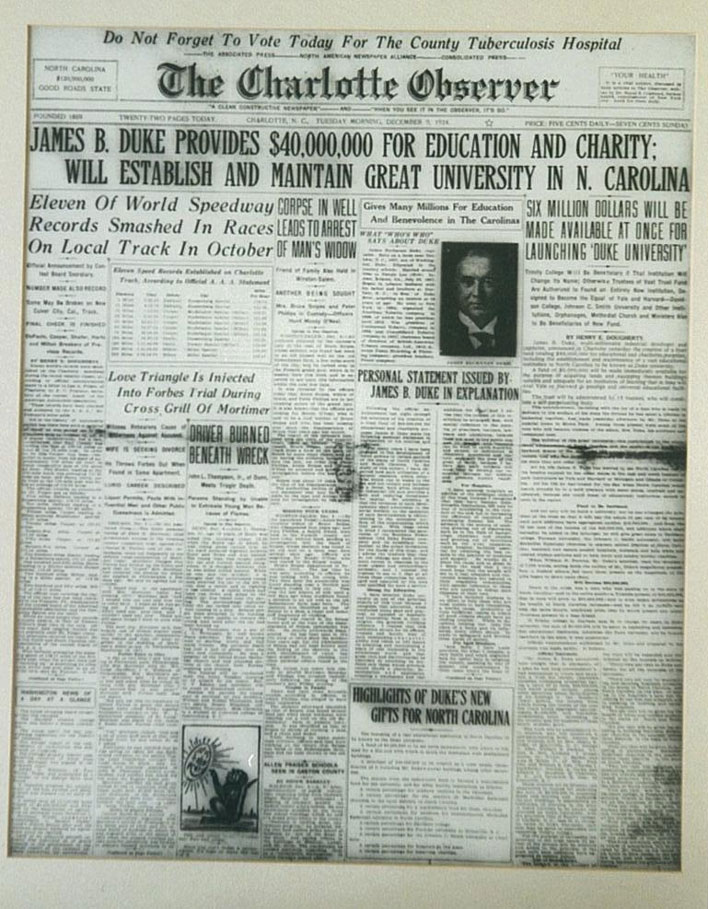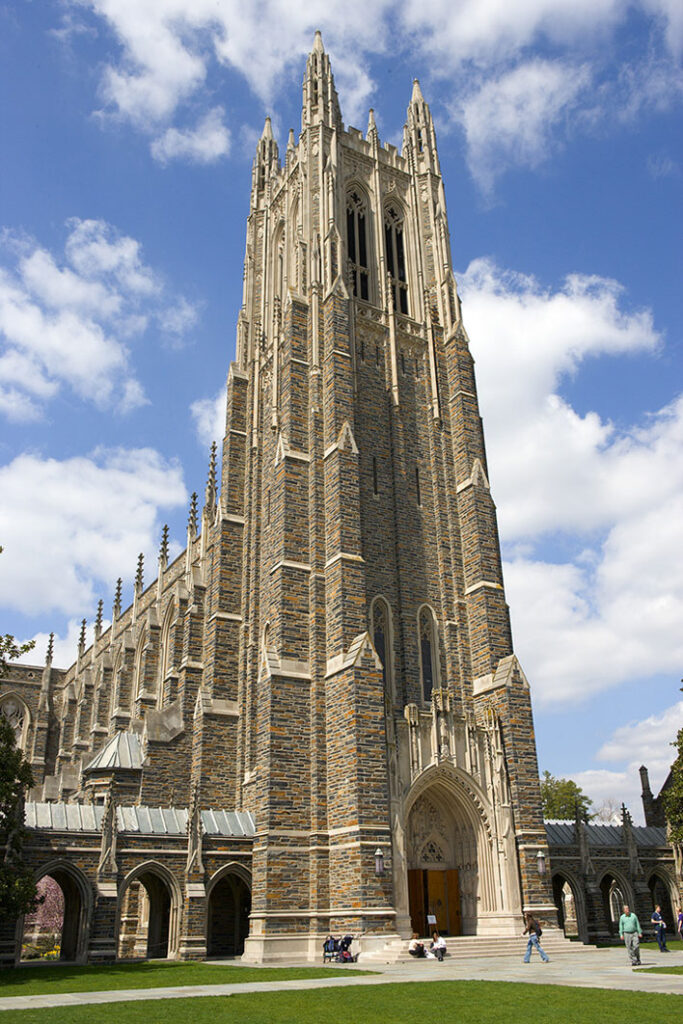As a cardinal flies, it’s only three miles from a modest tobacco farm near Ellerbe Creek to the campus of Duke University. Today, a traveler can cover the distance in about 10 minutes, entirely within the city limits of Durham, North Carolina.
That otherwise unremarkable distance marks the journey of James B. Duke. Born on a small homestead, and interred in the chapel of the university that bears his name, Duke was a man of the Carolinas.
No matter what else he became, James B. Duke remained a man of the Carolinas.
Tobacco made him one of the richest men in the world, and he created a worldwide market for North Carolina’s signature crop. In his career’s second act, he harnessed the power of Carolina streams, making possible the electrification—and the mighty textile industry—of the two states. And although he had a Fifth Avenue mansion in New York, although he had tobacco interests around the world and hydroelectric projects as far afield as Quebec, when he turned to philanthropy, he remained a man of the Carolinas.

On December 9, 1924, the Charlotte Observer broke big news for the Carolinas. Duke had established a significant philanthropic foundation. Duke’s attorney read the indenture of trust creating it, and “a hushed silence fell upon those present as the magnitude of the gifts began to dawn upon them.” The Duke Endowment was at the time a philanthropic legacy rivaled in size only by those established by Andrew Carnegie and John D. Rockefeller. But unlike Rockefeller’s and Carnegie’s foundations, Duke’s was intended only for the Carolinas. And unlike the open-ended charters of Rockefeller and Carnegie, Duke knew exactly what he wanted to fund: hospitals, orphan care, rural Methodist churches, three Carolina colleges—and Duke University, which he sought to turn into a world-class institution.
The story of Duke’s philanthropy is remarkable in two ways: first, for the way he identified, clarified, and documented his charitable purposes; and second, for the way his trustees have perpetuated those purposes. For unlike many foundations of Duke’s era, which spent the past century finding ways out of their founders’ designs, Duke’s trustees have sought to stay as close to his purposes as possible.
Smoking the Competition
Born in December 1856, James Buchanan Duke was named for the 15th President. His family—including his father, Washington, and his older brother Benjamin—called him “Buck,” and it seemed to suit him. He was a strong, sturdy child, eager for life.
The Duke family eked out a living on a small Piedmont farm. Washington raised his children in the Methodist church, and Buck grew up listening to circuit-riding preachers, hardworking evangelical entrepreneurs who wore themselves out in their ministries. “My old daddy always said that if he amounted to anything in life it was due to the Methodist circuit riders who frequently visited his home and whose preaching and counsel brought out the best that was in him,” he reminisced. “If I amount to anything in this world I owe it to my daddy and the Methodist church.”
By the end of the Civil War, North Carolina had been devastated—more than any other Southern state—and the Dukes were penniless. They made a new start with their one crop that had not been stripped away during the conflict: tobacco.
The small log outbuilding on the Duke family farm hardly bespoke great enterprise. In that 16 by 18 foot house, Washington Duke and his children beat, sifted, and packed the tobacco leaves, and Washington peddled the tobacco from a mule-drawn cart in eastern North Carolina.

In 1874, when Buck was 17, the family moved to Durham. The Dukes—Washington, Ben, and Buck in partnership—opened a tobacco factory there, but they found their potential in Durham limited by the fierce competition. Buck had a plan. “My company is up against a stone wall,” he said. “It can’t compete with Bull Durham [a popular rival]. Something has to be done and that quick. I am going into the cigarette business.” The Dukes were among the first cigarette manufacturers in the South, and they were the first to—at Buck’s recommendation—adopt machine production on a large scale. The risk paid off handsomely; the Dukes were able to produce far more cigarettes much faster than older methods.
To sell the growing surplus inventory, and build up consumer demand for the Duke brands, J. B. Duke pioneered national cigarette advertising. He used mass media, like tradable “cigarette pictures” and billboards. J. B.’s devout father was concerned about the suggestive pictures, and his competitors sniffed at “this damned picture business” that “degraded” the cigarette industry, but the advertising worked, and smokers across the country increasingly asked their local tobacconists for J. B.’s brands by name.
By 1890, J. B. Duke had become the nation’s leading tobacco magnate. Competition was fierce, with advertising costs accounting for about 20 percent of sales, and Duke, like many of his era’s industry titans, sought to limit competition and thus reduce costs. The Duke firm joined four others to form the American Tobacco Company, which accounted for upwards of 90 percent of the domestic cigarette business. Duke, who had orchestrated the merger, was at the helm of the new monopoly. By 1904, when American Tobacco incorporated yet more allied tobacco interests, it was involved in almost every single line of the tobacco business.
Tobacconist to the World
In 1901, Duke bought a major British tobacco company. His ambitions were increasingly global. This action alarmed many British manufacturers, who banded together, advertising with jingoistic jingles like “Rule, Britannia! Britannia rules the waves/Britons to Yankee trusts will ne’er be slaves!” Duke fought the British to a stalemate with a generous bonus for tobacco merchants, but this approach was expensive, and as with his American competitors, Duke saw no reason not to join forces. The result, in 1902, was the British-American Tobacco Company.
William C. Whitney, a former Secretary of the Navy and a member of New York’s famous Whitney family, was one of Duke’s colleagues in the merger. He believed that Duke had more in mind than just cornering the British tobacco trade. “His keenest satisfaction from this international triumph,” Whitney said, “came to him in the knowledge that he had gotten an almost unlimited and more lasting market for the tobacco made by his own people on their small farms.”
The first decade of the 20th century brought a wave of sadness to J. B. Duke. Washington Duke died in 1905. Later that year, after less than a year of marriage, J. B. filed for divorce from his wife, on grounds of (her) adultery. In 1907, the federal government brought an antitrust suit against American Tobacco under the Sherman Antitrust Act, and the Supreme Court ordered the company dissolved in 1911. Duke’s two bright spots during this time were his marriage to Nanaline Holt Inman in 1907, and the birth of their only child, Doris, in 1912.
Although he remained very much involved in British-American Tobacco, J. B. never returned to the tobacco industry with the same ardor of his youth. For he had a new enterprise: the hydroelectric development of the western Carolinas.
Duke Power
Although water power had been used for centuries to operate mills, in the early 20th century using it for electrical generation was still a novelty. But as turn-of-the-century America developed, Duke would find, its thirst for electric power would be slaked most efficiently by river power. Hydroelectricity would not only provide cheap power to the textile mills that dotted the Carolinas, Duke observed; it would also see that electrification would spread across the Carolinas, helping the states to advance in their development. (Duke’s foresight put him a generation ahead of government efforts to electrify the Tennessee River valley during the Great Depression.)
“For many years I have been engaged in the development of water powers in certain sections of the States of North Carolina and South Carolina,” J. B. wrote in the indenture creating the Duke Endowment. “In my study of this subject I have observed how such utilization of a natural resource, which otherwise would run in waste to the sea and not remain and increase as a forest, both gives impetus to industrial life and provides a safe and enduring investment for capital.”
Duke brought his entrepreneurial talents to his new hydropower business. His physician presented him with the idea of developing the Catawba River and introduced Duke to a 32-year-old engineer named W. S. Lee. Duke entrusted Lee with full authority to begin purchasing property and building dams; Duke did not even give Lee a set of instructions. “It was his policy to designate one man to begin and complete a thing rather than start a debating society or hold a town meeting over it,” Lee recalled.
Duke’s next task was to persuade mill owners to use the new source of energy. Electricity was cheap, but it wasn’t an easy sell. “You must be drunk or a damned fool if you think I will bring electricity into my mill to kill my people,” replied one mill owner. Other owners saw it differently, believing—in the words of one—that “yes, Mr. Duke will make it a success.”
Duke’s Southern Power Company grew by the 1920s into the leading electric utility in the western Carolinas. (After his death, it was renamed Duke Power, and it still operates today as Duke Energy.) In 1924, Duke won from the North Carolina Corporation Commission approval for a rate increase that would allow Southern Power to maintain its growth and meet the Carolinas’ increasing need for power.
Duke’s interests in Carolina hydropower brought him even closer to home. He continued to maintain his mansion in New York and his farm in New Jersey, but he built a new house in Charlotte, where Southern Power was headquartered, and began to spend more time there. Moreover, one can see in the way Duke developed his power company—securing steady revenue and foregoing personal dividends—the beginnings of his “grand design” for philanthropy in the Carolinas.
“Philanthropy on a Princely Scale”
J. B. Duke’s philanthropy did not spring fully formed from his head in 1924. Rather, it grew organically out of his life and interests. Duke always attributed his family’s success to their Methodist faith, a creed that stresses hard work. His interest in orphans came from his own experience of being a half-orphan. And the Duke family had for many decades generously supported Trinity College.
It is true, however, that J. B. was not a philanthropic heavyweight in the early years of his career. For one, he thought it better for him to make money when the making was good. “I am going to give a good part of what I make to the Lord, but I can make better interest for Him by keeping it while I live,” he said. Furthermore, in the Duke family’s division of labor, Ben tended to handle the philanthropy.

J. B. Duke took on more philanthropic responsibilities when Ben fell seriously ill in 1915. He took a personal interest in the design of Trinity’s new campus, and he began having funds for “worn-out” Methodist preachers and their widows and orphans distributed through Trinity. J. B. began giving on a large scale several years before he created the Duke Endowment.
Of course, even if J. B. Duke had not indicated his philanthropic objectives prior to 1924, after the Duke Endowment was created, it was impossible to ignore them. His indenture of trust imbues his philanthropy with the same confidence he had in his entrepreneurship. First, he created a university as a memorial to his father and brother. “An institution to be known as Duke University” was to receive $6 million from the endowment up front. And, given the Dukes’ long connection to Trinity, J. B.’s next condition was only natural: if Trinity was to rename itself accordingly, it would receive the $6 million to fund a new campus and new schools of divinity, law, and medicine. “I have selected Duke University as one of the principal objects of this trust because I recognize that education, when conducted along sane and practical, as opposed to dogmatic and theoretical, lines, is, next to religion, the greatest civilizing influence,” J. B. wrote. He intended that Duke University attain “a place of real leadership in the educational world.”
He identified four areas of funding, and allocated specific percentages of the endowment’s payout that would go to each. Four institutions of higher education together receive 46 percent of the payout: Duke was to receive 32 percent; Davidson College and Furman University, 5 percent each; and Johnson C. Smith University (a historically black university in Charlotte), 4 percent. Duke allocated 32 percent for hospitals in the Carolinas, 10 percent for the care of orphans and half-orphans in the Carolinas, 10 percent for the construction and maintenance of rural Methodist churches in North Carolina, and, finally, 2 percent for the support of elderly Methodist clergymen and their widows. Unlike Carnegie and Rockefeller, Duke focused his largesse in just two states—to give elsewhere, he thought, “would be productive of less good by reason of attempting too much.”
In addition to his strict percentages, Duke included a statement of principles to guide his trustees. He selected hospitals because of their benefits for helping the sick and for improving mankind. “I very much hope that the people will see to it that adequate and convenient hospitals are assured in their respective communities, with especial reference to those who are unable to defray such expenses of their own,” he explained. As to orphans, he wrote, “nothing can take the place of a home and its influences, [but] every effort should be made to safeguard and develop these wards of society.”
And, of course, he provided for the needs of his beloved Methodist church. A colleague once suggested that he give more ecumenically, but Duke demurred. “No, that would be the biggest kind of mistake,” he replied. “Competition in religion keeps up the interest.”
Finally, part of his grand design was to connect his philanthropy with a stable company: Southern Power. He instructed his trustees to hold only stocks in that company (except for some government bonds) and to maintain control of it. This part of his design was thwarted after the Tax Reform Act of 1969 forbade foundations to own more than half of a company’s shares; by 1994, the endowment had sold off most of its Duke Power holdings.
Duke didn’t stop giving after he created the endowment. Before his death in October 1925, Duke decided to give even more—$7 million extra—to ensure the completion of Duke University’s new campus and growth plans. He took a special pleasure in the design of Duke’s grand Gothic West Campus. “Don’t disturb me now; I am laying out the university grounds,” he said to his nurse days before he died. “I am looking to the future, how they will stand and appear a hundred years from now.”
“Persons of Character and Ability”
Duke had thrived in business because of his eye for talent. “He was an extremely keen judge of men and of their character and ability,” writes Duke biographer Robert Durden. He delegated a great deal of responsibility to his trusted employees, and rewarded them accordingly, including offering them stock in his businesses. “I have only one instruction to give you,” J. B. told one new hire. “Don’t ask me to raise your salary. I always know what my people are worth to me, and I pay them what they are worth without being asked.”

J. B. brought this eye for talent to his philanthropy. He entrusted the Duke Endowment to his closest personal and business associates. Two of them were relatives: wife Nanaline and A. J. Drexel Biddle Jr., Ben Duke’s son-in-law. (Mary D. B. T. Semans, Biddle’s eldest daughter, chaired the endowment from 1982 to 2001 and remains on the board today.) The endowment’s first chairman after Duke’s death was George Allen, who had first come to American Tobacco in 1895 and who worked closely with Duke in his New York office. William Perkins, Duke’s chief counsel since 1914, had drafted the indenture. These and other trustees repaid Duke’s loyalty; 8 of the original 12 stayed on the board for more than 25 years, and Allen remained chairman until 1960.
Duke instructed his trustees to “make a special effort to secure persons of character and ability, not only as trustees, but as officials and employees.” Trustee selection has been an important way of helping to honor Duke’s charitable purposes. “Of the 15 trustees, we still have 3 family members. That’s not specified in the indenture, but that’s been the practice to have family representation,” says Eugene W. Cochrane Jr., the endowment’s president. “They offer a spirit of the family that’s been important to the endowment.”
Meeting 10 times annually ensures that the trustees engage with each other and with the staff. Duke intended for his trustees to commit a good deal of time, and he rewarded them accordingly. Compensating foundation trustees is controversial, but Duke put it into the indenture. His purpose was to recruit persons of “ability” for the board, and it underscores the trustees’ moral and fiduciary obligation to pursue Duke’s charitable intent. Today’s board, chaired by Neil Williams, consists of business executives, professionals, and academics with some connection to the Carolinas.
And every year, the trustees follow another practice instituted by Duke: reading the full text of the indenture aloud at a board meeting. Although this practice originates in Duke’s aural learning style, it brings trustees face to face with their duty as stewards of Duke’s philanthropy. “After the reading, there is always a time of reflection and comment about Mr. Duke, his ideas, and our mission,” Semans says. “This closeness to the founder renews us and gives us a sense of new energy.”
The Duke Endowment Today
In the 86 years since its creation, the Duke Endowment has distributed more than $2.7 billion. All of these grants fall into the same categories—and similar percentages—established by J. B. Duke. “One of the great things Mr. Duke did was limit us to a geographic area,” says Cochrane—this geographic focus has allowed the endowment, as Duke predicted, to have a greater effect.
More than anything else, the endowment has achieved J. B. Duke’s goal for Duke University: that it become a world-class national research university. Every measure indicates that it has: the university is currently ninth in U.S. News & World Report’s domestic rankings, 24th in the Times Higher Education global rankings, and 35th in the Shanghai global rankings. “Trinity was a small Methodist college,” says Cochrane, “and Mr. Duke said, ‘I want it to become a great university’—and it has.”

The endowment’s support for nonprofit hospitals accelerated their development in the Carolinas; in the endowment’s first several decades, North Carolina’s rate of growth in hospital beds per 1,000 people was almost double those of comparable states. In terms of quality, Cochrane says, these hospitals “match up very favorably” against those in other southeastern states. But even from the earliest days of the endowment, the trustees and staff did not fund hospitals qua hospitals, but rather hospitals as a means to the “object of good medical service.” The Duke Endowment’s work—including funding the first group health plan in the Carolinas and putting the states ahead of the curve in outpatient care—ultimately raised standards of medical care in the Carolinas.
The bequest for care of orphans and half-orphans was, for the first few decades of the endowment, used to fund orphanages, Cochrane says. By the 1940s, orphanages had given way to foster homes, and the endowment began to give assistance for foster care. The endowment also funds programs to encourage adoption. And since Duke specifically mentions half-orphans in the indenture, the endowment today supports programs that serve children at risk of neglect and abuse.
The endowment’s grants for higher education have remained remarkably stable. Duke, Davidson, Furman, and Johnson C. Smith have benefited greatly from J. B. Duke’s largesse. (During the Great Depression, some of these schools received more revenue from the endowment than from tuition, a remarkable advantage.) In the 1960s, for example, the endowment supported Duke’s ambitious plan to raise its faculty salaries to a level competitive with the Ivy League. “I’d like to think the endowment has been a major part in making those schools as strong as they are as compared to all private colleges in the Carolinas,” Cochrane points out.
The endowment has departed from the letter of the indenture in some places—as Duke might have expected when he allowed his trustees “uncontrolled discretion” to make grants “in like manner.” For example, Duke specified that the endowment should give hospitals $1 for each day of charity care rendered, which was at the time a generous contribution. Today, of course, $1 per day per bed isn’t even a drop in the bucket. So, Cochrane explains, the trustees looked at what charity care meant today. “It’s largely in rural medical clinics and medical clinics that serve underserved populations.”
Some of the changes in what the endowment funded came from changes in the needs within the areas Duke sought to fund. “For many years, the endowment primarily provided capital support. And that was probably the need in the early to middle parts of the 20th century,” Cochrane says. “In the 1990s, that began to change. The endowment began moving toward more program support.” Today, although the endowment still occasionally funds capital projects, it also supports programs with grants of three types: “Strengthening Organizations,” “Advancing Innovation,” and “Replicating Success.”
The endowment is also funding more across multiple program areas. One current grant—to improve the physical health of clergy, which is worse than the average North Carolinian’s—is a collaboration led by the endowment’s rural church division, with support from its health care division, and inspired by Duke’s expression of care for “worn-out preachers.”
“Duke Did That”
How will the Duke Endowment adapt in the future? Cochrane says the Endowment is already thinking ahead. “Mr. Duke set up the indenture before you had health insurance, Medicare, and Medicaid,” he explains. Thus, the endowment’s original mandate for hospitals has been transformed. What does the current round of healthcare reform portend? “A lot of our dollars have been to help people without health insurance coverage. If the health plan stays in place, most of those people will be covered,” Cochrane points out. “You have all of a sudden all these people who have insurance and are therefore seeking health care—who’s going to provide it?”

“Our numbers show that there’s going to be a significant shortage in the health workforce,” he adds, “so we’re looking to see what we might fund in that area.”
The endowment is also working to bring highly effective national nonprofits to the Carolinas. “If you can identify those programs that really are proven,” says Cochrane, “why shouldn’t your strategy be to bring those programs into the Carolinas and replicate them here?” For example, the endowment has brought to 20 Carolina counties Nurse-Family Partnership, which provides first-time, low-income mothers with regular home visits from nurses, from pregnancy through infancy, helping parents provide a healthy home life.
In the days before his death, Duke was laboring over plans for a coal-fired power plant. He saw the need to adapt his vision of hydroelectricity and diversify sources of power. In so doing, he showed characteristic shrewdness. Likewise, his endowment continues to shrewdly meet the higher education, health, childcare, and rural church needs of today’s Carolinas, following Duke’s designs and desires.
“It is time I was beginning to think about a monument,” Duke said in 1923. “I want to leave something in the state that 500 years from now people can look upon and say that Duke did that.” Of the perpetual philanthropy of the Duke Endowment, Carolinians present and future can say as one: “Duke did that. And he still does.”
